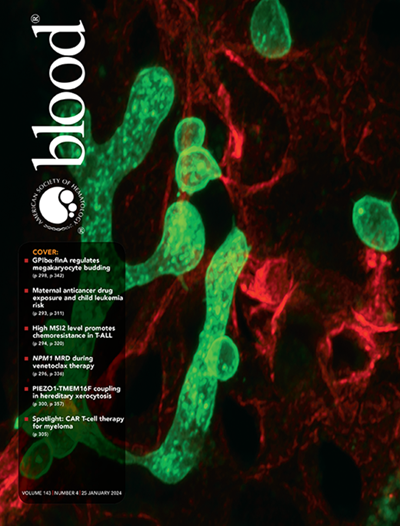靶抗原和浆细胞表型是对反应适应的达拉单抗治疗敏感性的关键因素。
IF 23.1
1区 医学
Q1 HEMATOLOGY
引用次数: 0
摘要
在这项针对新诊断的老年多发性骨髓瘤(MM)的反应适应临床试验中,我们发现靶抗原表达、浆细胞表型和激活的免疫微环境(iTME)是与CD38单克隆抗体治疗反应相关的关键特征。在这里,在2个周期后获得部分缓解(PR)的患者继续使用daratumumab,否则添加来那度胺或硼替佐米。该策略的总体缓解率为97%,不良事件发生率低,37%的患者能够继续接受达拉单抗单药治疗。重要的是,我们发现更高的CD38表达、浆细胞基因表达编程和激活的iTME与能够继续单抗治疗的患者相关。相比之下,需要添加来那度胺或硼替佐米的患者的粘附、TNF信号、KRAS信号和B细胞程序以及免疫抑制iTME的表达增加。克隆动力学的跟踪表明,在仅两个周期的daratumumab单药治疗后,亚克隆的选择丰富了新生耐药基因表达程序。复发后,daratumumab难愈性MM细胞的特征是先前存在的小亚克隆扩增,其混合转录组程序包含CD38降低的浆细胞表型和维持耐药程序,这表明获得性耐药的发展涉及治疗naïve肿瘤中存在的转录程序的解偶联。据我们所知,这是第一个证明反应适应达拉图单抗治疗有效性的研究,并描述了单药达拉图单抗敏感性的关键生物标志物,治疗naïve MM患者。NCT04151667。本文章由计算机程序翻译,如有差异,请以英文原文为准。
Target antigen and plasma cell phenotype are critical factors for sensitivity to response-adapted daratumumab therapy.
In this response-adapted clinic trial with daratumumab monotherapy for elderly newly diagnosed multiple myeloma (MM), we identified target antigen expression, a plasma cell phenotype, and an activated immune microenvironment (iTME) as critical features associated with response to CD38 monoclonal antibody therapy. Here, patients achieving a partial response (PR) after 2 cycles continued daratumumab, otherwise lenalidomide or bortezomib was added. This strategy resulted in an overall response rate of 97% and low rates of adverse events, with 37% of patients able to continue daratumumab monotherapy. Importantly, we found that higher CD38 expression, plasma cell gene expression programming, and an activated iTME were associated with patients who were able to continue daratumumab therapy alone. In contrast, patients requiring the addition of lenalidomide or bortezomib had increased expression of adhesion, TNF signaling, KRAS signaling, and B cell programs as well as an immunosuppressed iTME. Tracking of clonal dynamics illustrated the selection of subclones enriched for de novo resistance gene expression programs after only two cycles of daratumumab monotherapy. Upon relapse, daratumumab refractory MM cells were characterized by the expansion of pre-existing minor subclones with mixed transcriptomic programs containing the plasma cell phenotype with decreased CD38 and maintenance of resistance programs, suggesting development of acquired resistance involves an uncoupling of transcriptional programs present in therapy naïve tumors. To our knowledge, this is the first study to demonstrate the effectiveness of response-adapted daratumumab treatment and describe critical biomarkers of single-agent daratumumab sensitivity in vulnerable, therapy naïve MM patients. NCT04151667.
求助全文
通过发布文献求助,成功后即可免费获取论文全文。
去求助
来源期刊

Blood
医学-血液学
CiteScore
23.60
自引率
3.90%
发文量
955
审稿时长
1 months
期刊介绍:
Blood, the official journal of the American Society of Hematology, published online and in print, provides an international forum for the publication of original articles describing basic laboratory, translational, and clinical investigations in hematology. Primary research articles will be published under the following scientific categories: Clinical Trials and Observations; Gene Therapy; Hematopoiesis and Stem Cells; Immunobiology and Immunotherapy scope; Myeloid Neoplasia; Lymphoid Neoplasia; Phagocytes, Granulocytes and Myelopoiesis; Platelets and Thrombopoiesis; Red Cells, Iron and Erythropoiesis; Thrombosis and Hemostasis; Transfusion Medicine; Transplantation; and Vascular Biology. Papers can be listed under more than one category as appropriate.
 求助内容:
求助内容: 应助结果提醒方式:
应助结果提醒方式:


